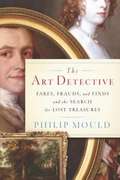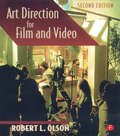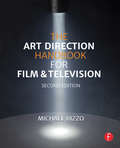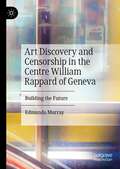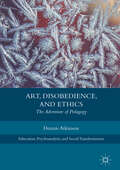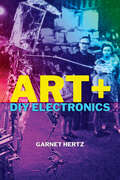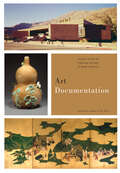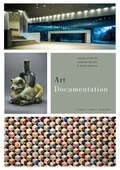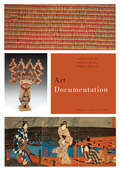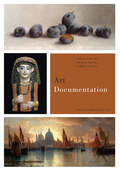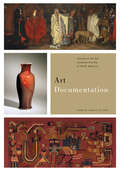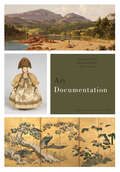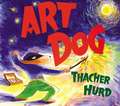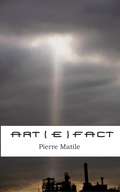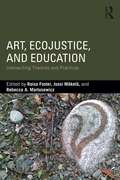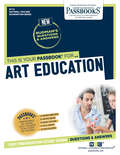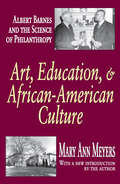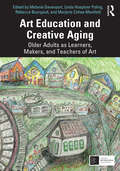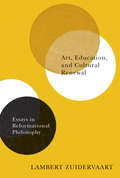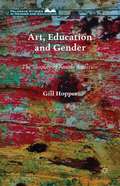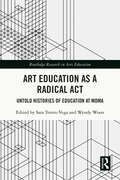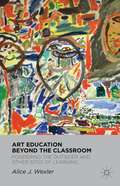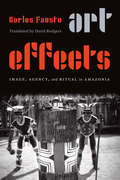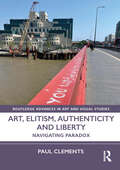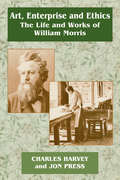- Table View
- List View
The Art Detective
by Philip MouldThe supremely telegenic star of the original Antiques Roadshow dishes up his best tales of uncovering lost masterpieces and unmasking fakes. How can you tell a masterpiece from a piece of junk? Philip Mould has been so successful at discovering buried treasures that he's affectionately known as "the art detective. " Now, at last, he has decided to let the eleven million fans of Antiques Roadshow in on his secrets. Each chapter revolves around a particular painting and the people who helped unmask its creator's identity-from an ingeniously forged Norman Rockwell (good enough to fool the Rockwell Museum) to a Winslow Homer found in a dump. Witty and compulsively readable, The Art Detective is memoir, art history, and brilliant storytelling all rolled into one. .
Art Direction for Film and Video
by Robert OlsonWritten by an author with over 30 years of working experience, this book takes a practical, thorough look at the duties and skills of art directors and production designers. It teaches readers how to analyze a script, develop concepts that meet the needs of a script, develop sketches and construction drawings, work with directors and producers, and operate within budget limitations. The book has been updated and expanded to include interviews with professionals at all levels in the art department. A chapter on digital effects as they relate to the work of the art director has been added to this new edition. Students, novices in the profession, and persons from other art/design fields who are interested in expanding into film and video will find this is a valuable resource. Written by an author with over 30 years of working experience, this book takes a practical, thorough look at the duties and skills of art directors and production designers. It teaches readers how to analyze a script, develop concepts that meet the needs of a script, develop sketches and construction drawings, work with directors and producers, and operate within budget limitations. The book has been updated and expanded to include interviews with professionals at all levels in the art department. A chapter on digital effects as they relate to the work of the art director has been added to this new edition. Students, novices in the profession, and persons from other art/design fields who are interested in expanding into film and video will find this is a valuable resource.
The Art Direction Handbook for Film & Television
by Michael RizzoIn this new and expanded edition of The Art Direction Handbook, author Michael Rizzo now covers art direction for television, in addition to updated coverage of film design. This comprehensive, professional manual details the set-up of the art department and the day-to-day job duties: scouting for locations, research, executing the design concept, supervising scenery construction, and surviving production. Beyond that, there is an emphasis on not just how to do the job, but how to succeed and secure other jobs. Rounding out the text is an extensive collection of useful forms and checklists, as well as interviews with prominent art directors.
Art Discovery and Censorship in the Centre William Rappard of Geneva: Building the Future
by Edmundo MurrayThis is a history of the Centre William Rappard, the first building designed to house an international organization in Geneva, and its art treasures. For nearly a century, these works of art and decorations offered by governments and institutions encouraged smooth diplomacy and fluent international negotiations in the fields of labour, trade and human rights. On occasions hidden, removed and forgotten, and then recovered and restored, the history of the artworks in the Centre William Rappard represents the confrontation between art as diplomatic device and aesthetic experience, between representation and represented, between censorship and free expression. Even before its opening in 1926, the building started receiving works from the International Labour Organization member governments. Some pieces, such as the Geneva Window by Harry Clarke, never arrived in Geneva since it was censored by the Irish government. The Spanish Pygmalion by Eduardo Chicharro y Agüera was latter covered for its female nudity and remained hidden during decades. Later in the 1970s the secretariat of the General Agreement on Tariffs and Trade occupied the building and requested the removal of other major works. This was reversed in the 2010s by its successor the World Trade Organization, when many artworks were rediscovered, restored and placed in their original locations. However, new values in the world scene contributed to further changes in the building art, including the removal of Claude Namy’s caricature In GATT We Trust from public view in 2019. Art in the Centre William Rappard continues to speak to the viewer after waves of positive reception, censorship and recovery.
Art, Disobedience, and Ethics: The Adventure of Pedagogy (Education, Psychoanalysis, and Social Transformation)
by Dennis AtkinsonThis book explores art practice and learning as processes that break new ground, through which new perceptions of self and world emerge. Examining art practice in educational settings where emphasis is placed upon a pragmatics of the 'suddenly possible', Atkinson looks at the issues of ethics, aesthetics, and politics of learning and teaching. These learning encounters drive students beyond the security of established patterns of learning into new and modified modes of thinking, feeling, seeing, and making.
Art + DIY Electronics
by Garnet HertzA systematic theory of DIY electronic culture, drawn from a century of artists who have independently built creative technologies.Since the rise of Arduino and 3D printing in the mid-2000s, do-it-yourself approaches to the creative exploration of technology have surged in popularity. But the maker movement is not new: it is a historically significant practice in contemporary art and design. This book documents, tracks, and identifies a hundred years of innovative DIY technology practices, illustrating how the maker movement is a continuation of a long-standing creative electronic subculture. Through this comprehensive exploration, Garnet Hertz develops a theory and language of creative DIY electronics, drawing from diverse examples of contemporary art, including work from renowned electronic artists such as Nam June Paik and such art collectives as Survival Research Laboratories and the Barbie Liberation Front. Hertz uncovers the defining elements of electronic DIY culture, which often works with limited resources to bring new life to obsolete objects while engaging in a critical dialogue with consumer capitalism. Whether hacking blackboxed technologies or deploying culture jamming techniques to critique commercial labor practices or gender norms, the artists have found creative ways to make personal and political statements through creative technologies. The wide range of innovative works and practices profiled in Art + DIY Electronics form a general framework for DIY culture and help inspire readers to get creative with their own adaptations, fabrications, and reimaginations of everyday technologies.
Art Documentation: Journal of the Art Libraries Society of North America, volume 40 number 2 (Fall 2021)
by Art Documentation: Journal of the Art Libraries Society of North AmericaThis is volume 40 issue 2 of Art Documentation: Journal of the Art Libraries Society of North America. Art Documentation: Journal of the Art Libraries Society of North America is a peer-reviewed journal presenting issues of concern to librarians working within art history, art criticism, the history of architecture, archaeology, and similar areas. The journal has established itself as a vital publication for art information professionals, acting as a forum for issues relating to both the documentation of art and the practice and theory of art librarianship and visual resources curatorship. Art Documentation will publish articles pertinent to issues surrounding the documentation of art and the use of visual resources in academic and special libraries and museum settings. It is a key resource for professionals entering the field as well as those more seasoned professionals.
Art Documentation: Journal of the Art Libraries Society of North America, volume 41 number 1 (Spring 2022)
by Art Documentation: Journal of the Art Libraries Society of North AmericaThis is volume 41 issue 1 of Art Documentation: Journal of the Art Libraries Society of North America. Art Documentation: Journal of the Art Libraries Society of North America is a peer-reviewed journal presenting issues of concern to librarians working within art history, art criticism, the history of architecture, archaeology, and similar areas. The journal has established itself as a vital publication for art information professionals, acting as a forum for issues relating to both the documentation of art and the practice and theory of art librarianship and visual resources curatorship. Art Documentation will publish articles pertinent to issues surrounding the documentation of art and the use of visual resources in academic and special libraries and museum settings. It is a key resource for professionals entering the field as well as those more seasoned professionals.
Art Documentation: Journal of the Art Libraries Society of North America, volume 41 number 2 (Fall 2022)
by Art Documentation: Journal of the Art Libraries Society of North AmericaThis is volume 41 issue 2 of Art Documentation: Journal of the Art Libraries Society of North America. Art Documentation: Journal of the Art Libraries Society of North America is a peer-reviewed journal presenting issues of concern to librarians working within art history, art criticism, the history of architecture, archaeology, and similar areas. The journal has established itself as a vital publication for art information professionals, acting as a forum for issues relating to both the documentation of art and the practice and theory of art librarianship and visual resources curatorship. Art Documentation will publish articles pertinent to issues surrounding the documentation of art and the use of visual resources in academic and special libraries and museum settings. It is a key resource for professionals entering the field as well as those more seasoned professionals.
Art Documentation: Journal of the Art Libraries Society of North America, volume 42 number 1 (Spring 2023)
by Art Documentation: Journal of the Art Libraries Society of North AmericaThis is volume 42 issue 1 of Art Documentation: Journal of the Art Libraries Society of North America. Art Documentation: Journal of the Art Libraries Society of North America is a peer-reviewed journal presenting issues of concern to librarians working within art history, art criticism, the history of architecture, archaeology, and similar areas. The journal has established itself as a vital publication for art information professionals, acting as a forum for issues relating to both the documentation of art and the practice and theory of art librarianship and visual resources curatorship. Art Documentation will publish articles pertinent to issues surrounding the documentation of art and the use of visual resources in academic and special libraries and museum settings. It is a key resource for professionals entering the field as well as those more seasoned professionals.
Art Documentation: Journal of the Art Libraries Society of North America, volume 42 number 2 (Fall 2023)
by Art Documentation: Journal of the Art Libraries Society of North AmericaThis is volume 42 issue 2 of Art Documentation: Journal of the Art Libraries Society of North America. Art Documentation: Journal of the Art Libraries Society of North America is a peer-reviewed journal presenting issues of concern to librarians working within art history, art criticism, the history of architecture, archaeology, and similar areas. The journal has established itself as a vital publication for art information professionals, acting as a forum for issues relating to both the documentation of art and the practice and theory of art librarianship and visual resources curatorship. Art Documentation will publish articles pertinent to issues surrounding the documentation of art and the use of visual resources in academic and special libraries and museum settings. It is a key resource for professionals entering the field as well as those more seasoned professionals.
Art Documentation: Journal of the Art Libraries Society of North America, volume 43 number 1 (Spring 2024)
by Art Documentation: Journal of the Art Libraries Society of North AmericaThis is volume 43 issue 1 of Art Documentation: Journal of the Art Libraries Society of North America. Art Documentation: Journal of the Art Libraries Society of North America is a peer-reviewed journal presenting issues of concern to librarians working within art history, art criticism, the history of architecture, archaeology, and similar areas. The journal has established itself as a vital publication for art information professionals, acting as a forum for issues relating to both the documentation of art and the practice and theory of art librarianship and visual resources curatorship. Art Documentation will publish articles pertinent to issues surrounding the documentation of art and the use of visual resources in academic and special libraries and museum settings. It is a key resource for professionals entering the field as well as those more seasoned professionals.
Art Dog
by Thacher HurdSomeone has stolen the Mona Woofa from the Dogopolis Museum of Art and it's up to Art Dog, the mysterious, masked painter, to find the missing masterpiece. With the same high-spirited fun and adventure that have made Mystery on the Docks and Mama Don't Allow such perennially popular stories, Hurd serves up a new action-packed tale to delight young readers.
Art(e)fact
by Pierre MatileIn this world that we barely know and understand, this world so full of supposition and assumptions, we strive to make sense of this cluster of cells that constitutes us, sometimes on purpose, some other times unintentionally. We fill in the time and space with useless acts, we make public scraps of oneself, scraps of you, scraps of us, scraps of yourselves too sometimes, and seldom, very seldom, scraps of them, of other people that we observe through our machine designed to decipher reality, being in a constant search of identity, of eternity.
Art, EcoJustice, and Education: Intersecting Theories and Practices
by Raisa Foster Jussi Mäkelä Rebecca A. MartusewiczEmphasizing the importance of contemporary art forms in EcoJustice Education, this book examines the interconnections between social justice and ecological well-being, and the role of art to enact change in destructive systems. Artists, educators, and scholars in diverse disciplines from around the world explore the power of art to disrupt ways of thinking that are taken for granted and dominate modern discourses, including approaches to education. The EcoJustice framework presented in this book identifies three strands—cultural ecological analysis, revitalizing the commons, and enacting imagination—that help students to recognize the value in diverse ways of knowing and being, reflect on their own assumptions, and develop their critical analytic powers in relation to important problems. This distinctive collection offers educators a mix of practical resources and inspiration to expand their pedagogical practices. A Companion Website includes interactive artworks, supplemental resources, and guiding questions for students and instructors.
ART EDUCATION: Passbooks Study Guide (National Teacher Examination Series (NTE) #Nt-13)
by National Learning CorporationThe National Teacher/PRAXIS Examinations are designed to provide objective measurement of the knowledge, skills and abilities required of teachers. The Passbook® for the Art Education exam provides hundreds of multiple-choice questions in the areas that will likely be covered on your upcoming certification test.
Art, Education, and African-American Culture: Albert Barnes and the Science of Philanthropy
by Mary Ann MeyersA physician who applied his knowledge of chemistry to the manufacture of a widely used antiseptic, Albert Barnes is best remembered as one of the great American art collectors. The Barnes Foundation, which houses his treasures, is a fabled repository of Impressionist, post-Impressionist, and early modern paintings. Less well known is the fact that Barnes attributed his passion for collecting art to his youthful experience of African-American culture, especially music. Art, Education, and African-American Culture is both a biography of an iconoclastic and innovative figure and a study of the often-conflicted efforts of an emergent liberalism to seek out and showcase African American contributions to the American aesthetic tradition.Mary Ann Meyers examines Barnes's background and career and the development and evolution of his enthusiasm for collecting pictures and sculpture. She shows how Barnes's commitment to breaking down invidious distinctions and his use of the uniquely arranged works in his collection as textbooks for his school, created a milieu where masterpieces of European and American late-nineteenth and early-twentieth century painting, along with rare and beautiful African art objects, became a backdrop for endless feuding. A gallery requiring renovation, a trust prohibiting the loan or sale of a single picture, and the efforts of Lincoln University, known as the "black Princeton," to balance conflicting needs and obligations all conspired to create a legacy of legal entanglement and disputes that remain in contention.This volume is neither an idealized account of a quixotic do-gooder nor is it a critique of a crank. While fully documenting Barnes's notorious eccentricities along with the clashing interests of the main personalities associated with his Foundation, Meyers eschews moral posturing in favor of a rich mosaic of peoples and institutions that illustrate many of the larger themes of American culture in general and African-American culture in particular.
Art Education and Creative Aging: Older Adults as Learners, Makers, and Teachers of Art
by Melanie Davenport Linda Hoeptner Poling Rébecca Bourgault Marjorie Cohee ManifoldThis text explores how art education can meaningfully address the needs of older adults as learners, makers, and teachers of art in formal and informal settings. It combines perspectives of museum educators, teacher preparation professors, art therapists, teaching artists, and older artists on what is meant by Creative Aging and the ways art education can support the health and well-being of this population. Most importantly, the book discusses what the field of art education can gain from older adult learners and creators.Chapters are organized into five sections: Creatively Aging, Meeting Older Adults’ Unique Needs, Intergenerational Art Education, Engaging Older Adults With Artworks and Objects, and In Our Own Voices: Older Adults as Learners, Makers, and Teachers. Within each section, contributors investigate themes critical to art education within aging populations such as memory loss, disability, coping with life transitions, lifelong learning, intergenerational relationships, and personal narrative. The final section focuses on accounts from older adult artists/educators, offering insights and proposing new directions for growing older creatively.Though ideal for art education faculty and students in graduate and undergraduate settings, as well as art education scholars and those teaching in multigenerational programs within community settings, this book is an expansive resource for any artist, student, or scholar interested in the links among health, well-being, and arts participation for older adults.
Art, Education, and Cultural Renewal: Essays in Reformational Philosophy
by Lambert ZuidervaartWhat good is art? What is the point of a university education? Can philosophers contribute anything to social liberation? Such questions, both ancient and urgent, are the pulse of reformational philosophy. Inspired by the vision of the Dutch religious and political leader Abraham Kuyper, reformational philosophy pursues social transformation for the common good. In this companion volume to Religion, Truth, and Social Transformation, Lambert Zuidervaart presents a socially engaged philosophy of the arts and higher education. Interacting with the ideas of leading Kuyperian thinkers such as Calvin Seerveld and Nicholas Wolterstorff, Zuidervaart shows why renewal in the arts needs to coincide with political and economic transformation. He also calls for education and research that serve the common good. Deeply rooted in reformational philosophy, his book brings a fresh and inspiring voice to current discussions of religious aesthetics and Christian scholarship. Art, Education, and Cultural Renewal is a testament to the practical and intellectual richness of a unique religious tradition, compelling in its call for social solidarity and cultural critique.
Art, Education and Gender: The Shaping Of Female Ambition (Palgrave Studies in Gender and Education)
by Gill HopperWhy do girls study art and why do girls become primary teachers? This book examines and reveals the powerful influence of the family, the school and the state in shaping female identity and constructing notions of gender appropriateness. It also discusses the status of art at school and the position of women artists in society.
Art Education as a Radical Act: Untold Histories of Education at MoMA (Routledge Research in Arts Education)
by Sara Torres-Vega Wendy WoonThis comprehensive volume highlights and centers untold histories of education at the Museum of Modern Art (MoMA) from 1937 to 2020, using the critical voices of artists, scholars, designers, and educators. Exploring these histories as transformative and paradigm-shifting in museum education, it elevates MoMA educators as vocal advocates for harnessing the educational power that museums inherently possess.Divided into three interlinked parts, the first sheds light on the early educational endeavors of the museum while analyzing the context of art education in the United States. The second part focuses on the tenures of Victor D’Amico and Betty Blayton, utilizing the MoMA archives as a primary resource. It includes essays by Ellen Winner, Luis Camnitzer, Susan E. Cahan, Michelle Millar Fisher, HECTOR (Jae Shin & Damon Rich), Gregory Sholette, Carol Duncan, Moreen Maser, Nana Adusei-Poku, Carmen Mörsch, Rika Burnham, Donna M. Jones, and José Ortiz. The third part presents the perspectives of William Burback, Philip Yenawine, Patterson Sims, Deborah F. Schwartz, and Wendy Woon as former MoMA Directors of Education in their own words and considers the forces that shaped their work. This timely and unique exploration ultimately aims to trace and understand the fundamental and evolving concerns of a seemingly underexamined profession constantly striving to maintain relevance in an environment marked by institutional, social, and political uncertainty. Exploring the radical acts undertaken to keep the museum true to its original promise, it delineates the paradox whereby education is both central and invisible to the identity of MoMA and museums more broadly and re-centers the conception of the museum as an educational institution.It is designed for scholars, researchers, and post-graduate students interested in arts education, visual literacy, museum studies, and communication studies.
Art Education Beyond the Classroom
by Alice J. WexlerBy focusing on children and adults with disabilities, each contributor offers critical research which challenges the non-transferable divide between us and them , encouraging art teachers, therapists, critics, and general readers alike to uncover their biases regarding the nature of art and education.
Art Effects: Image, Agency, and Ritual in Amazonia
by Carlos FaustoIn Art Effects Carlos Fausto explores the interplay between indigenous material culture and ontology in ritual contexts, interpreting the agency of artifacts and indigenous presences and addressing major themes in anthropological theory and art history to study ritual images in the widest sense. Fausto delves into analyses of the body, aerophones, ritual masks, and anthropomorphic effigies while making a broad comparison between Amerindian visual regimes and the Christian imagistic tradition. Drawing on his extensive fieldwork in Amazonia, Fausto offers a rich tapestry of inductive theorizing in understanding anthropology&’s most complex subjects of analysis, such as praxis and materiality, ontology and belief, the power of images and mimesis, anthropomorphism and zoomorphism, and animism and posthumanism. Art Effects also brims with suggestive, hemispheric comparisons of South American and North American indigenous masks. In this tantalizing interdisciplinary work with echoes of Franz Boas, Pierre Clastres, and Claude Lévi-Strauss, among others, Fausto asks: how do objects and ritual images acquire their efficacy and affect human beings?
Art, Elitism, Authenticity and Liberty: Navigating Paradox (Routledge Advances in Art and Visual Studies)
by Paul ClementsThis book excavates the depths of creative purpose and meaning-making and the extent to which artist autonomy and authenticity in art is a struggle against psychological conditioning, controlling cultural institutions and markets, key to which is representation.The chapters are underpinned by examples from the arts, and the narrative weaves a trail through a range of conceptualizations that are applied to various aspects of visual culture from mainstream canonical arts to avant-garde, community and public art; social and political art to commercial art; and ethereal art to the popular, edgy and kitsch. The book is wide-ranging and employs various aesthetic, cultural, philosophical, political, psycho-social and sociological debates to highlight the problems and contradictions that an encounter with the arts and creativity engenders.The book will be of interest to scholars working in art history, museum studies, arts management, cultural policy, cultural studies and cultural theory.
Art, Enterprise and Ethics: The Life and Works of William Morris
by Charles Harvey Professor Jon Press Jon PressThe life and works of William Morris continue to excite the imaginations of fresh generations of scholars working in many traditions, from the history of art and design to literary criticism and the history of socialism and socialist thought. This book concentrates on Morris's social and political acheivements as well as his artistic talents.
